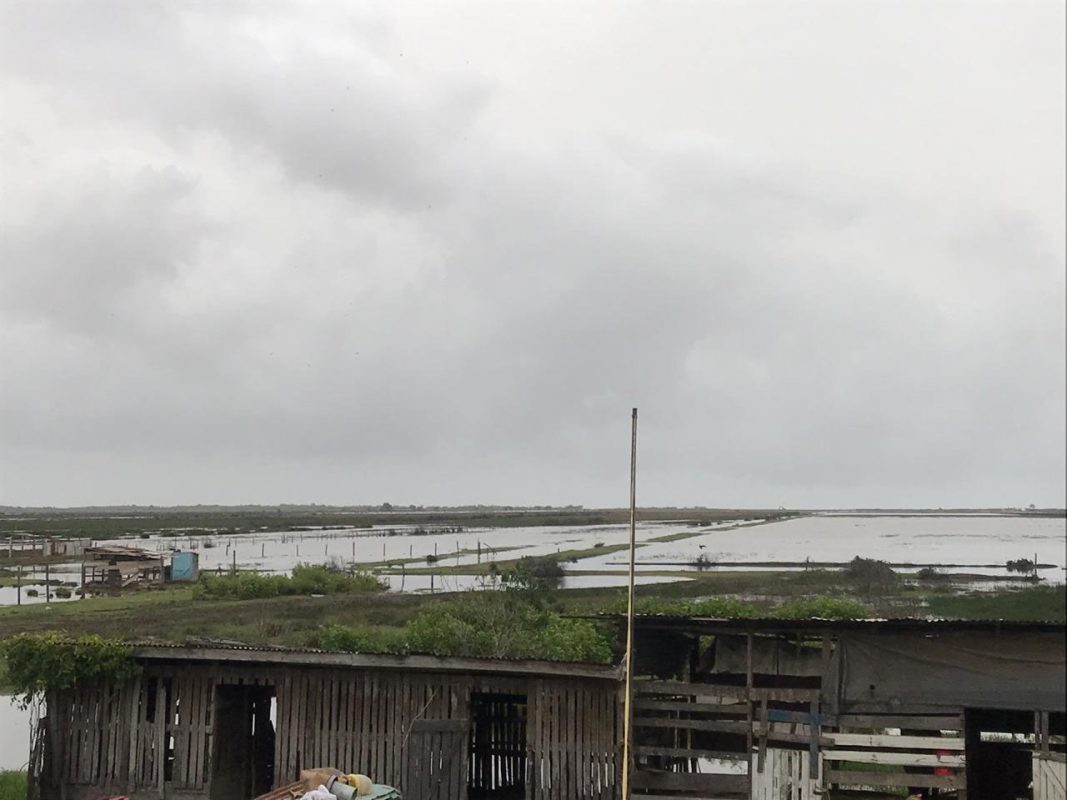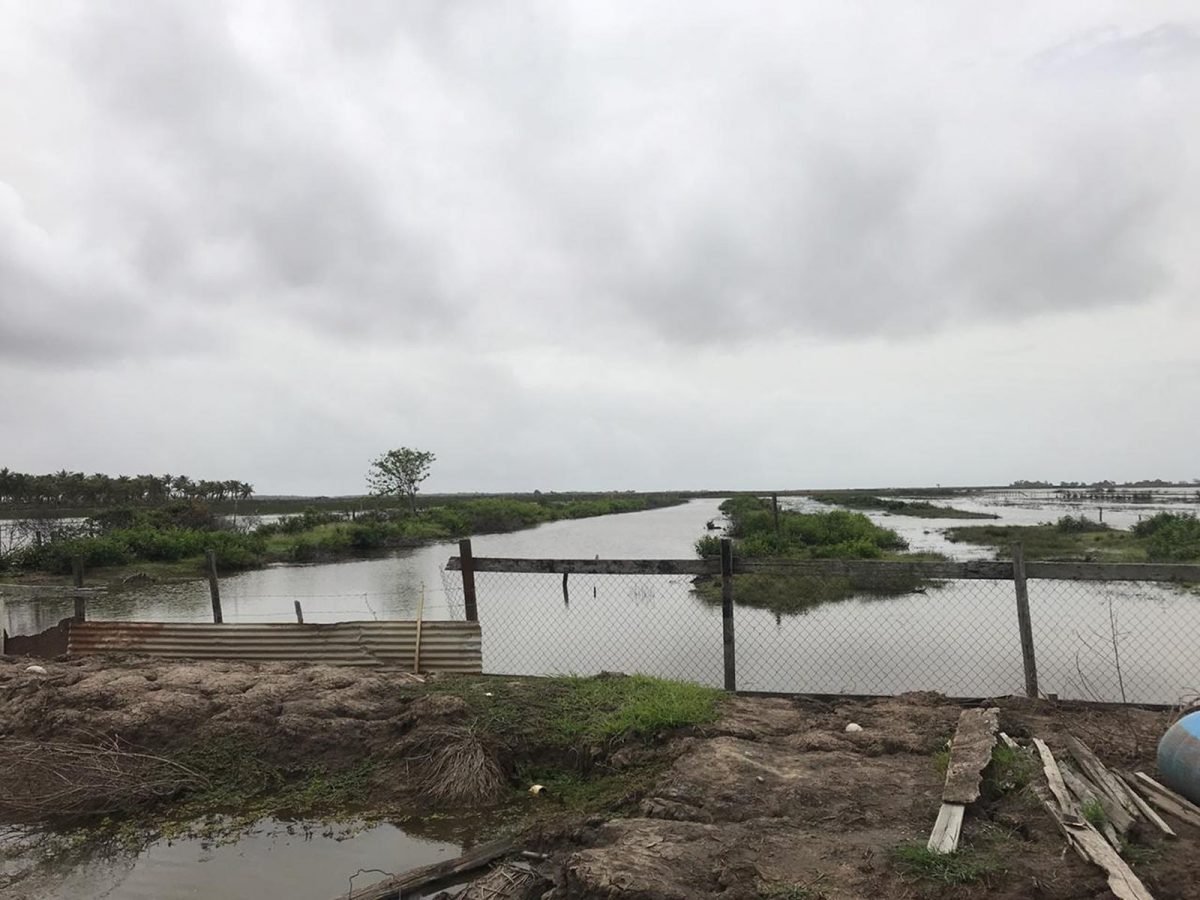Water from the Atlantic Ocean has once again inundated Mahaicony farmlands at Dantzig, East Coast Demerara following high tides and small breaches in the sea defence.
Since Saturday, residents of the affected communities – Dantzig and Content – have observed the rising water levels which pose a threat to their crops and livestock.
The Mahaicony shoreline has been a part of an erosion cycle and as a result has been rapidly wearing away.

The mangrove fringe and other natural sea defences that were in place have been washed away leaving just a narrow dam, which is now exposed and being battered daily by the ocean waves.
Still reeling from the invasion of saltwater from the last flood in November last year, many farmers rearing cattle and other livestock are once again affected as the lands that were once used for rice cultivation and pasture for their animals are yet again submerged in saltwater.
At present, residents told Stabroek News that not only has the saltwater invaded the lands on the northern side of the village, but it has made its way into farmlands and is now a threat to rice under cultivation on the southern side of the village.

Jermaine Brathwaite, Project Manager at the Ministry of Public Infrastructure’s River and Sea Defence Department, told Stabroek News that a contractor is on site and will be undertaking permanent works to strengthen and stabilise the sea defence.
He noted that they have also begun consultation with some other contractors to execute works on a kilometer- stretch of sea defence which is west of the current breach. However, he said that the biggest constraint for the department is the sourcing of funding since these are emergency works.
Brathwaite emphasised that with that section of the shoreline falling victim to the erosion cycle there is a natural depletion of the mangrove forest and this caused the breaches along the coast.
A contract was recently awarded to BK International to execute permanent works on 500 meters of the eroding berm. The company is presently on site and has started preparatory works for the construction of a rip-rap sea-defence, site Engineer Troy Krishna told Stabroek News.
He however noted that the affected section of the sea defence, which is approximately 60 meters, is not a part of the contract that was awarded. Krishna was quick to note that the damage to the specific section is not severe and residents only became affected due to overtopping from spring tides over the weekend.
Affected resident and community advocate, Neil Machado, told Stabroek News that he was forced to remove his cattle from the pasture as the water levels were steadily rising. He had to bring his cattle to an occupied piece of land close to the road.
“The animals can’t survive in the salt water so we had to move them because there was no food to eat and water to drink. Everyone had to move their cows and sheep,” Machado said.
He went on to state that with this being the second intrusion of salt water into the lands used to cultivate rice, they are nowhere close to using the lands for future rice crops.
“It is very frustrating for us at this time because within months we are flooded again by salt water. We haven’t gotten back anything from the last flood and now we are flooded again… it is life, we can’t get a break,” he bemoaned.
Another affected resident, Atoya Felix, told this newspaper that the return of the salt water has created uncertainty for their future in farming.
“From the last flood we lost a few sheep and fowl. We recently went back to NAREI [National Agricultural Research and Extension Institute] and bought chicks and ducklings to restart the operations but now I am afraid of what will happen because we are flooded again,” she said.
The woman explained that they are faced with uncertainty as they continue to invest in livestock and crops but they are unable to sell to make a profit due to the floods.
“We don’t get any help, we always investing but we are not able to gain any profit. It is hard for us as farmers. We always get visits and promises from the people at the Ministry of Agriculture but we get nothing. They know of our situation but they don’t say we can go to NAREI and receive younglings or some sort of supplements for the animals that survive. We get no help,” Felix lamented.
Donna Alphonso, a hassar and cash crop farmer said that since last November her pond has been contaminated with salt water. This, she says, has affected her severely as she is no longer able to go to the markets regularly. She recently prepared her farm and started planting but now she is fearful that the flood waters would kill the young plants.
“You know when I was rearing the hassars, I could have depended on that because I could have been able to get a $25,000 a week but now the pond is filled with salt water and the shallow well in the pond is blocked up so I cannot get hassars,” the woman noted.
She pointed out that in the last flood, her entire farm suffered damage as the salt water lingered for several days.
Other farmers, Lloyd Alphonso and Maniram Alves, told this newspaper that they too were forced to remove their cattle and sheep from the pasture as it is submerged in salt water from the ocean. They said they have been suffering losses since the last flood as the calves and lambs drowned in the flooding.
“We are farmers, this is a countryside, this is what we do for a living and our daily bread for myself, wife, and children, depends on farming but it has not been profitable in the last couple months and the government does not see it fit to help us with any compensation or any soil test so we can know if we can start plant back or what. Nothing they don’t help us with,” Alphonso said before adding that they would invest a majority of their earning into their farms with the expectation of making a profit.
Additionally, the residents called on the traffic department to issue advisories to motor vehicle drivers to be on the look-out for animals on the road and to proceed with caution when driving between Columbia to Mes Delices, since their animals would be on road due to the flooding of the community.
They called too on the health authority to conduct fogging exercises since there has been an infestation of mosquitoes as a result of floodwaters.
While in the past the National Drainage and Irrigation Authority had created earthen berms to prevent the lands between Columbia and Fairfield from being flooded during high tides, this was not done for the residents who are now affected.

